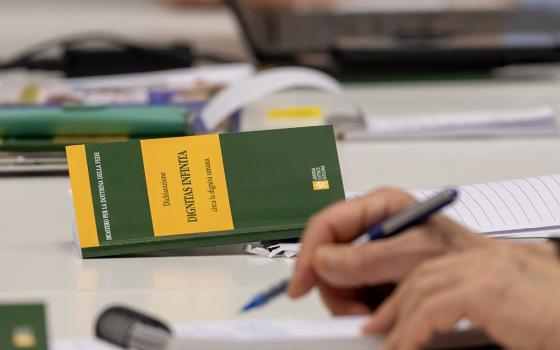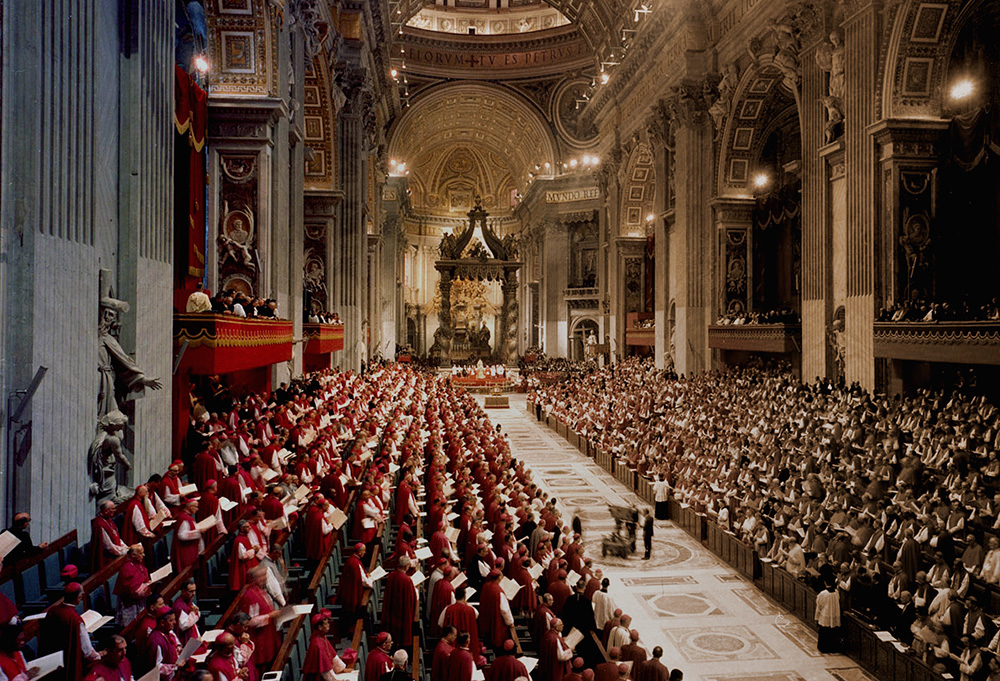
Bishops fill St. Peter's Basilica during a meeting of the Second Vatican Council. (CNS/Catholic Press Photo)
Robert Barron, auxiliary bishop of Los Angeles since 2015, is the most popular and influential cyber-evangelist in American Catholicism. In 2000, he also founded Word on Fire, an interesting experiment of web-based Catholic apologetics and retrieval of the contribution of key thinkers relevant for theology and the church.
One of the latest editorial initiatives of Word on Fire is the elegantly designed volume The Word on Fire Vatican II Collection, published in March. The book includes, in this order:
- The opening speech of the Second Vatican Council by Pope John XXIII, Gaudet Mater Ecclesia, of Oct. 11, 1962;
- The complete texts of the four constitutions (Dei Verbum on divine revelation, Scripture and tradition; Lumen Gentium on the church; Sacrosanctum Concilium on the liturgy; Gaudium et Spes on the church in the modern world);
- The closing address of Vatican II by Pope Paul VI of Dec. 7, 1965;
- An afterword by Matthew Levering;
- A glossary of key terms and figures;
- "Frequently Asked Questions" about Vatican II.
The texts of the four constitutions are interspersed with long excerpts from the post-conciliar popes (including Paul VI) commenting on key issues raised by particular paragraphs of the constitutions.
The book opens in a promising way, with the choice to publish Gaudet Mater Ecclesia, which is hermeneutically important to understand Vatican II in the intention of the pope who called it, John XXIII. That speech plays an important role in the statements of Pope Francis on the interpretation of Vatican II.
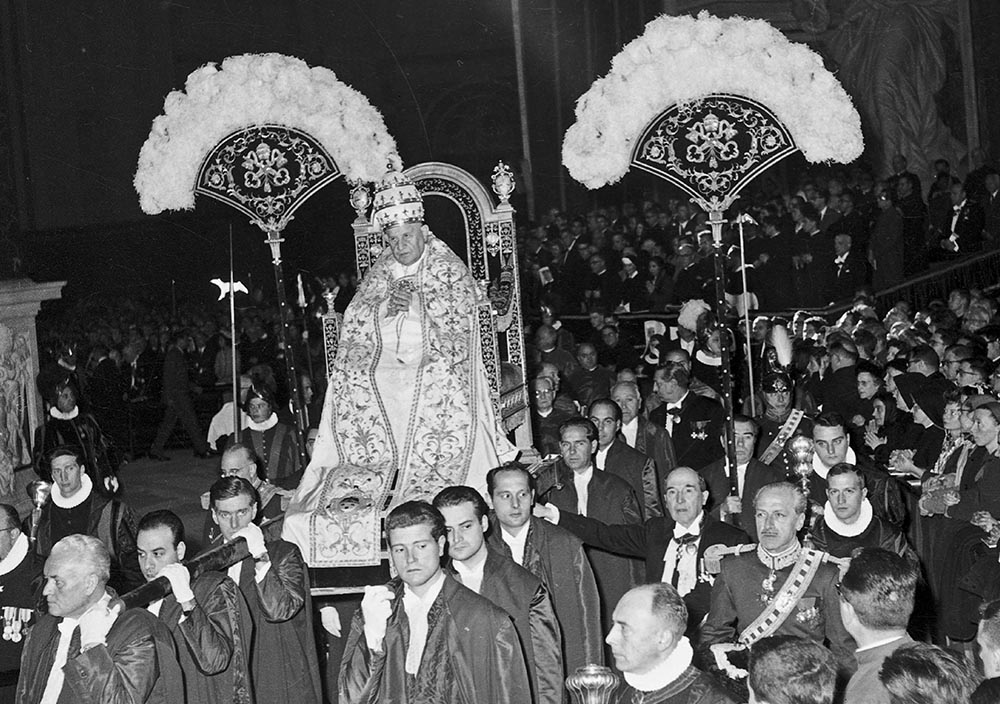
Pope John XXIII leads the opening session of the Second Vatican Council in St. Peter's Basilica Oct. 11, 1962. (CNS/L'Osservatore Romano)
Other choices made by Barron are less convincing, for example, the decision to publish the texts of the four constitutions in English using the official Vatican translation (which is available also online for free). It is true that there is still no consensus on which English translation is the best one, the last one (by Austin Flannery in 1996) now more than 25 years old. But the Vatican translation is notoriously a little careless in some passages, besides sounding evidently gender noninclusive (more in English than in the original Latin).
The order in which the four constitutions are published is not explained by the editor, but it seems to be more theological than historical, with the choice of Dei Verbum on revelation being the first. But when Vatican II actually opened in 1962, the conciliar debates started — and for precise reasons having to do with the strong consensus around the need for a reform of the liturgy — with the schema De Liturgia leading to Sacrosantum Concilium, the first of the four constitutions, promulgated in December 1963.
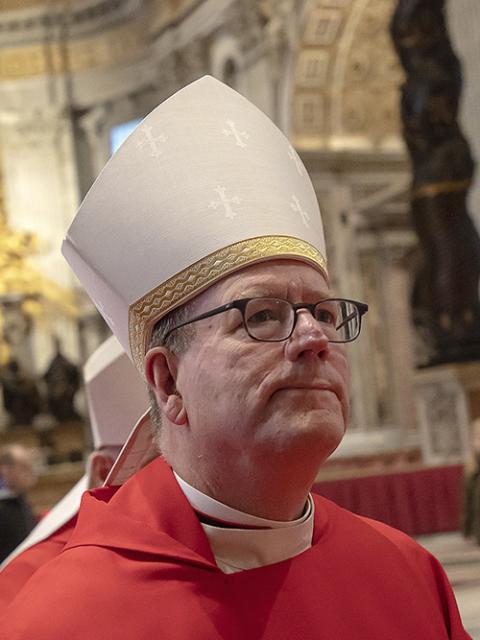
Los Angeles Auxiliary Bishop Robert Barron in St. Peter's Basilica at the Vatican Jan. 27, 2020 (CNS/Stefano Dal Pozzolo)
It's from the introduction that Barron shows his intention: responding to traditionalists' assault against the legitimacy of Vatican II, which has been rampant for a few years now in Catholic blogs and the internet. This anti-Vatican II narrative had a surge since the paraschismatic attempt by Carlo Maria Viganò, former apostolic nuncio to the United States who tried to unseat Francis in August 2018, turned later into a bizarre narrative on contemporary Catholicism that Viganò and his followers see as a catastrophe made possible by the teachings of the council.
Barron has talked about this surge of anti-Vatican II cyber-traditionalism in this last year, especially in his lecture "Pope Francis and Vatican II" for the Napa Institute retreat in 2020.
In the introduction to The Word on Fire Vatican II Collection, Barron lays his cards on the table: His intention is to respond to the traditionalists' assault: "A fresh controversy has broken out, this time prompted by 'traditionalists' who claim that Vatican II has betrayed authentic Catholicism and produced disastrous consequences in the life of the Church."
Barron calls, with an understatement hard to understand, Vatican II "one of the most significant cultural and ecclesiastical events of the twentieth century." Actually, Vatican II was the single most important event for Catholicism in four centuries, since the Council of Trent.
This book is a response against the new enemies of Vatican II, the Catholic "rad-trads," but without forgetting Barron's other polemical objects. Here Barron in the introduction again: "I and Word on Fire stand firmly with Vatican II and hence against the radical traditionalists. And we stand firmly with the Wojtyla-Ratzinger interpretation of the council, and hence against the progressives."
This is a false equivalence. The hermeneutics of Vatican II by the radical opposition against the very legitimacy of the theology of Vatican II is significantly different than that by progressives in favor of an expanded interpretation of Vatican II according to the spirit of Vatican II (as questionable as that appeal can be sometimes).
The intention to recover Vatican II is laudable and begins from undisputable fact that Barron recognizes: "I believe that the documents of Vatican II are still widely unread, and if they are read, often misunderstood. The needful thing, I am convinced, is a robust and enthusiastic reappropriation of the texts of Vatican II. I hope that this book represents a contribution to that project."
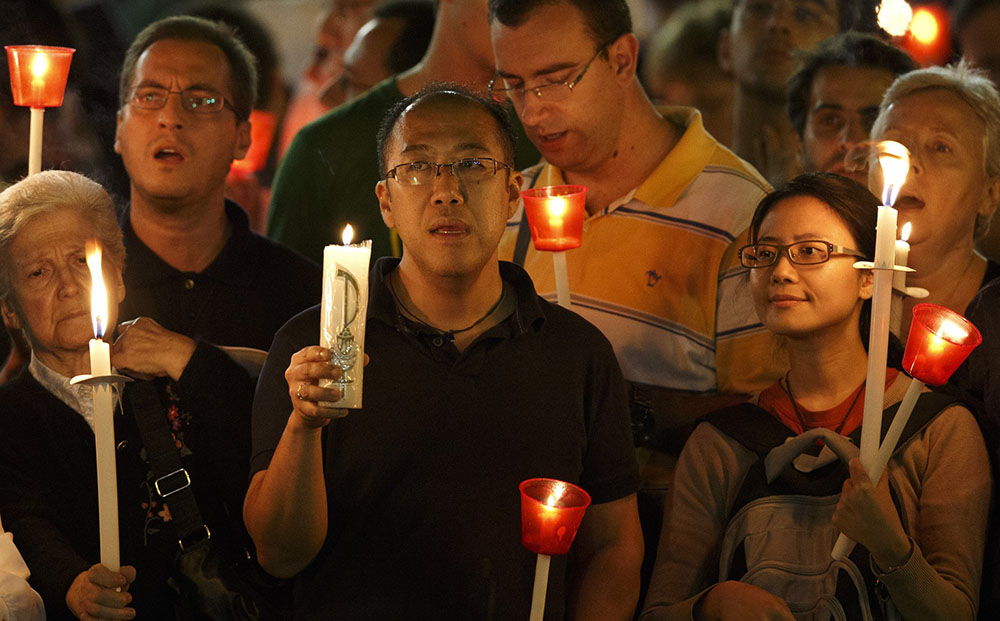
Pilgrims attend a candlelight vigil in St. Peter's Square at the Vatican Oct. 11, 2012, to mark the 50th anniversary of the opening of the Second Vatican Council. (CNS/Paul Haring)
The problem is that the texts of Vatican II are not just the four constitutions presented in this volume: There are 12 more of them. Someone who would start to learn about Vatican II from this volume would have no way of knowing that. It is true that the four constitutions belong to a higher category of conciliar teachings, but this assumption has been relativized in the post-Vatican II period, and not just by progressive theologians, but also by popes, if one looks, for example, at the role of the declaration Nostra Aetate on non-Christian religions in the pontificate of Pope John Paul II (not to mention Francis).
The interpretive stance that dominates the whole volume is "the hermeneutic of continuity," inspired by Pope Benedict XVI, but in a particular American version dismissive of historical nuance.
The afterword by Matthew Levering, a prolific author and editor of volumes defending the "hermeneutics of continuity," expands with some context on the other documents of Vatican II and grants that the declaration on religious liberty provides "valuable doctrinal development." At the same time, Levering also tries to highlight the continuity between Dignitatis Humanae, the Vatican II document on religious freedom, which is not published in the volume, and the Syllabus of Errors by Pius IX (1864), which denied religious liberty to non-Catholics (among other things).
Advertisement
It remains to be explained why, if they are in continuity, Dignitatis Humanae never quotes the syllabus nor Pius IX. In this way, understanding the historical development of the Catholic tradition becomes impossible.
As an alternative to the battles between Scholastic and ressourcement theologians around Vatican II, Levering encourages "a ressourcement Thomism in which the two sides make a good faith effort to find good things to say about the other side." But this approach narrows down drastically the spectrum of legitimate voices and excludes other significant streams in the global Catholic Church today.
Some of the replies in the nine pages of FAQ at the end of the volume provide effective talking points against anti-Vatican II traditionalism, but the real enemies seem to be still on the other side.
For example, a quotation from Cardinal Robert Sarah explains that the polemical target of this operation is not really a defense of Vatican II, but a defense of an idea of Catholic doctrine as absence of change: "Those who make sensational announcements of change and rupture are false prophets. They do not seek the good of the flock. They are mercenaries who have been smuggled into the sheepfold. Our unity will be forged around the truth of Catholic doctrine. There are no other means."
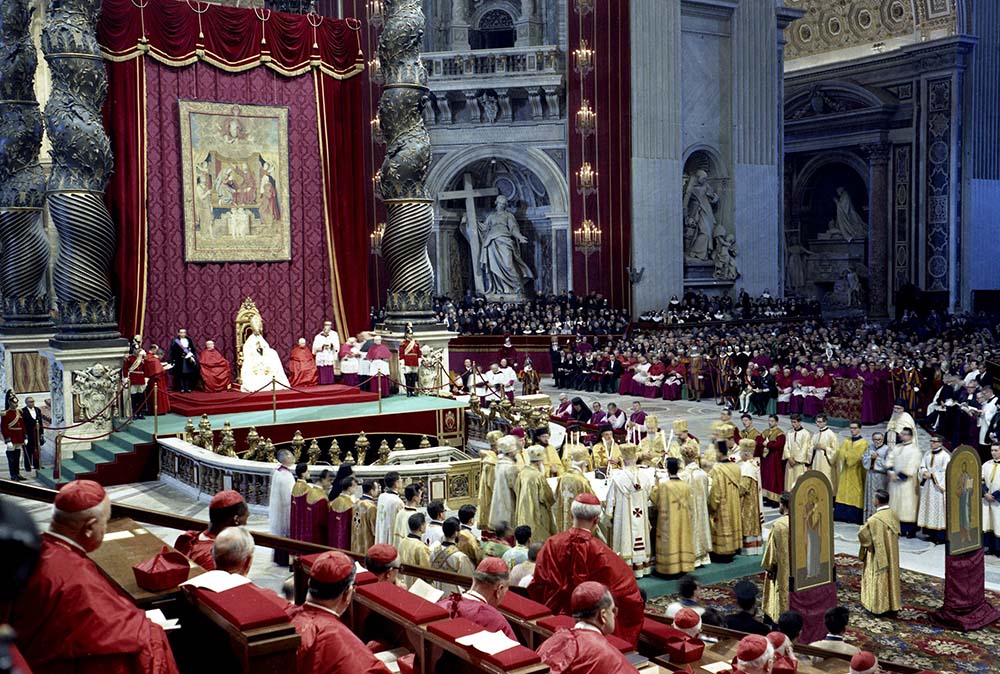
Pope Paul VI presides over a meeting of the Second Vatican Council in St. Peter's Basilica at the Vatican in 1963. (CNS/Catholic Press Photo)
The history of the magisterium teaches us that not all changes are ruptures, and not all material continuities with the previous tradition ensure continuity with the Gospel. It is also misleading to say that "the same magisterium that gave us the ecumenical council of Vatican II also gave us Pope Benedict XVI's motu proprio [Summorum Pontificum on the 'traditional Latin Mass']," almost implying that the teaching of a general council like Vatican II and the motu proprio of a pope are on the same level of authority.
A book like this tries, with commendable courage, to take a stand against radical traditionalists (finally!). But at the same time, it functions as a symptom of the crisis that made "rad-trads" emerge in the first place.
The problem is not the anti-progressive move underlying this book, but the theological myopia that prompts the move. The theological interpretation offered here is made possible only by the silences on other aspects of Vatican II: This makes it impossible to know not just Vatican II, but also the post-Vatican II church. The conciliar decree on ecumenism is barely mentioned, only in the afterword, and ecumenism does not even figure in the glossary.
Moreover, if in the theological interpretation of Vatican II one does not include the discontinuities of documents like Dignitatis Humanae on religious liberty and Nostra Aetate on non-Christian religions, the whole "good Catholic conservatives vs. progressives as false prophets" narrative becomes a caricature.
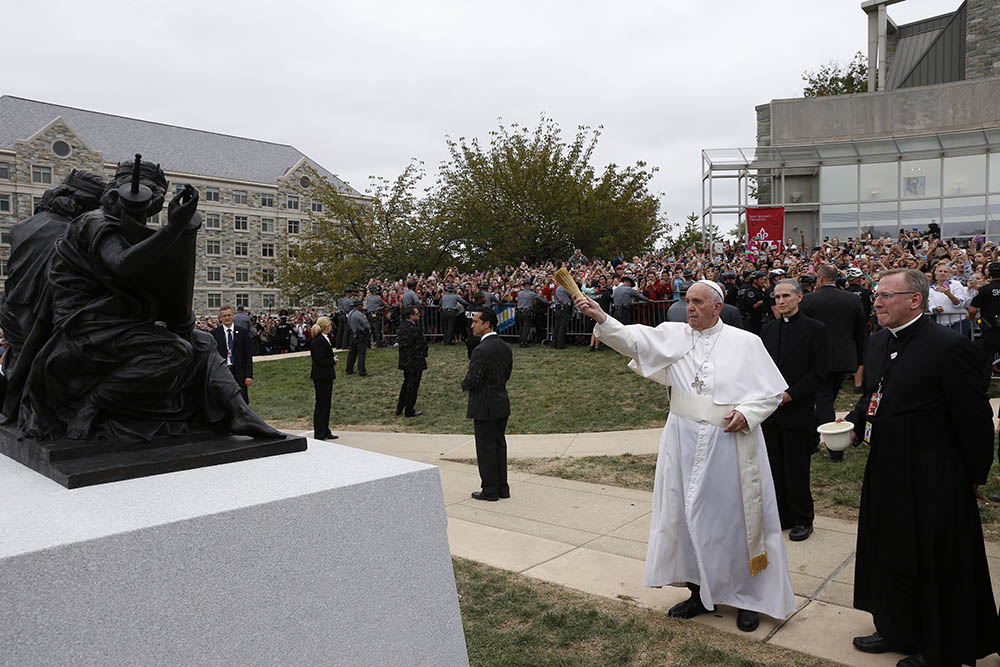
At St. Joseph's University in Philadelphia Sept. 27, 2015, Pope Francis blesses a sculpture commemorating the 50th anniversary of "Nostra Aetate," the Second Vatican Council Declaration on the Relationship of the Church to Non-Christian Religions. (CNS/Paul Haring)
This volume provides one more evidence of the de-theologization of the Catholic leadership in the context of the "culture wars." The silence of the volume on the conciliar teaching on religious liberty corresponds to the almost totally legal and constitutional, nontheological argument of the U.S. bishops' campaign for religious liberty in the last 10 years. This is Exhibit A for the mutual estrangement between Catholic hierarchy and sound historical-theological scholarship.
Barron's and Levering's preference for Hans Urs von Balthasar over Bernard Häring fits understandably with their theology, yet Häring was a very active participant of Vatican II, while Balthasar was absent.
Much less acceptable is the presentation of Vatican II as an ecclesial and theological event that seems all enclosed within the European and North American hemisphere. In the glossary of key figures there are no Latin American, African or Asian participants, and their contribution to the council (for example, to the liturgical debate) is not considered. To miss the fact that Vatican II was a global Catholic event means missing a key historical-theological point with catastrophic consequences.
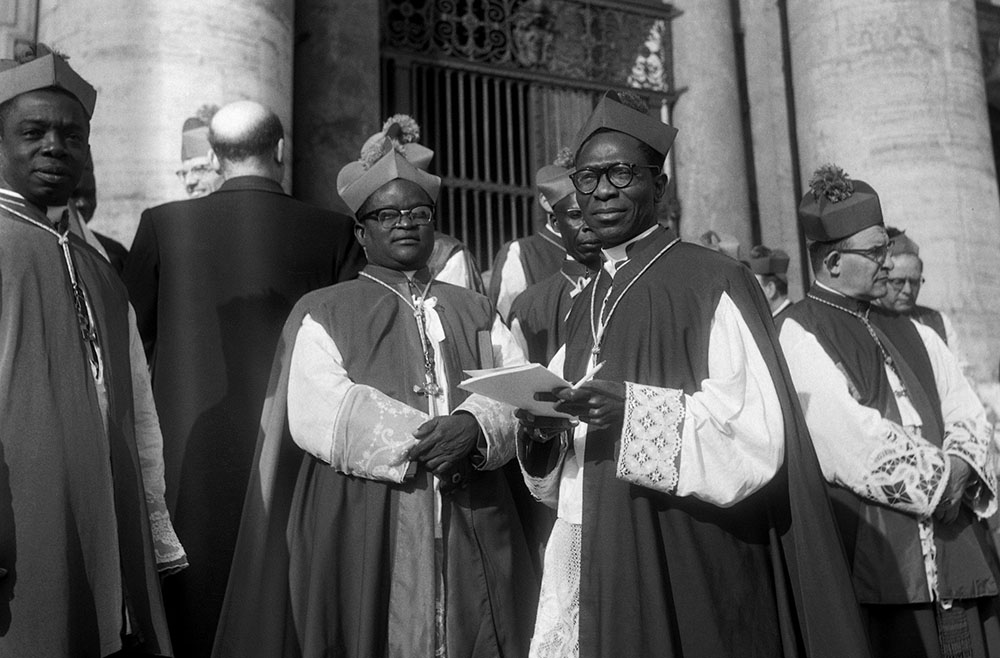
Bishops are pictured on the steps of St. Peter's Basilica following a meeting of the Second Vatican Council in 1962. (CNS/Catholic Press Photo/Giancarlo Giuliani)
In the glossary of key terms, among the most conspicuous absences there are religious freedom, non-Christian religions, Judaism, Islam. The absence of religious liberty from the book explains only up to a point the absence from the glossary of Jesuit Fr. John Courtney Murray, the most important U.S. Catholic theologian at Vatican II.
Pope Francis is included in the excerpted comments on the four constitutions, but that is all. This book reacts to what happened in the Catholic cyberspace in the last few years, but does not register what Francis has contributed in terms of overall narrative to the interpretation of Vatican II.
Francis' teaching is absent, but it would have made sense, given the professed intention of the volume, to mention especially Francis' decisions about traditionalism (see, for example, the abolition of the Pontifical Commission Ecclesia Dei in 2019).
Francis is in good company with the best English-speaking scholarship on Vatican II in the last two decades: There is no mention of the works of Joseph Komonchak, John O'Malley, Ormond Rush, Richard Gaillardetz, Gerald O'Collins and Catherine Clifford. (Full disclosure: Levering falsely accuses one of my books, the one on liturgy and ecclesiology, of "rejecting the letter" of the council.)
Fulton Sheen seems instead to offer much more insights to the editors of this volume. Bishop Sheen participated in Vatican II but spoke only once at the council and left no significant trace in the conciliar corpus.
It is fine to look for a popular and pastoral voice like Sheen to try and make sense of the turbulence of the post-conciliar period for the audience of Word on Fire. And I understand that for Barron, it is much more difficult to do, in the 21st century, what Sheen did in the 20th century in a much more religion- and church-friendly cultural and media system.
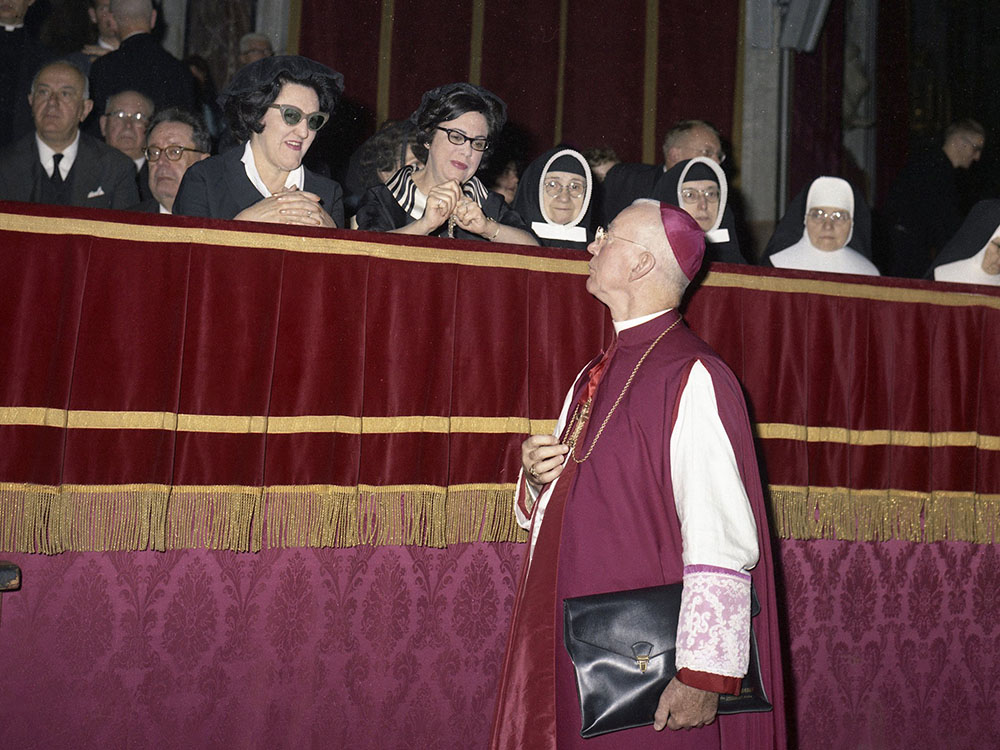
A bishop speaks with two laywomen during a meeting of the Second Vatican Council in St. Peter's Basilica at the Vatican in 1962. (CNS/Catholic Press Photo/Giancarlo Giuliani)
But it is indefensible the total absence of women from this volume, both in terms of their contribution to preparation and celebration of the conciliar event (they were there, even though not as voting members) and to the hermeneutics of Vatican II. From this book, one gets the impression that the council was and has to remain strictly a male business. The only three women mentioned are St. Catherine of Siena, St. Bridget of Sweden and St. Edith Stein, to whose care Europe was dedicated by John Paul II.
As I have written elsewhere, I believe that Catholic theology, especially in the English-speaking context, has left Vatican II in something like a no man's land between an anti-Vatican II traditionalism and a post-Vatican II and post-institutional progressivism. For the former, Vatican II is too modern to be Catholic; for the latter, Vatican II is too Catholic to be modern. This is at the root of the intellectual and theological crisis of U.S. Catholicism today.
The Word on Fire Vatican II Collection is the most important effort of a U.S. Catholic bishop to defend Vatican II, but Barron presents a Vatican II that is safe for a certain kind of traditionalism. This collection of texts and commentaries wants to recover a healthy and necessary Vatican II centrism. That intention has real merit.
But this work actually expresses an extremist centrism that remains friendly to nonschismatic traditionalism and risks being indifferent to the interpretation of the readers of today, almost 60 years after the beginning of the council. This deepens the problem of connecting the teaching of Vatican II with the church and world of today, including the present pope.
Barron is a theologian and founder of a Catholic movement, but he is also a bishop for the universal Catholic Church, and a celebrated one. As a pastor, a little more generosity toward conciliar hermeneutics would be in order, even if they do not exactly match his taste. With this kind of defense of Vatican II, Barron, ironically, serves up a version of the "beige Catholicism" he has complained about elsewhere.



